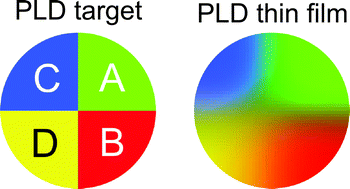Continuous composition spread using pulsed-laser deposition with a single segmented target
Abstract
The exploration and optimization of new material classes have been considerably accelerated and made highly efficient by combinatorial methods. Concerning thin film deposition of oxide materials, pulsed-laser deposition (PLD) has been mostly applied for the creation of a continuous composition spread (CCS). Up to now, two or more targets were ablated sequentially and movable masks shadowed varying parts of the substrate to create the CCS. In this letter, we report on the realization of a suggestion of Hanak (J. Mater. Sci., 1970, 5, 964) made for sputter deposition and present various types of easy to realize CCS by using a single segmented PLD target. We model the elemental distribution and thickness variation within a two inch thin film for different experimental parameters. Further, we have deposited a thin film with one-dimensional CCS for MgxZn1−xO and found that the Mg concentration changes linearly across a 2 inch substrate. Further, we show for MgxZn1−xO:Al that this approach is suited for the realization of two-dimensional CCS with a linearly varying composition in two perpendicular composition gradients. Further geometries are suggested, illustrating the potential of this CCS technique.


 Please wait while we load your content...
Please wait while we load your content...